The first Austrian sea-going Battleships: After the three Monarchs in 1898, the director of shipbuilding Siegfried Popper studied the design of a deep-sea battleship, the first since the Tegetthof of 1878. Unfortunately, the low credits allocated for its construction generated a ship inferior to other battleships of the Time: In terms of tonnage, the new design first claimed only 8,200 tons standard, while at the same time, the German SMS Wittelsbach claimed 12,700 tons, the Borodino 13,500, the French Republic 14,600, and the British Duncan 13 700 tons. This low tonnage generated limits of hull strength and artillery size, such as the standard “normal” of that time, 12in (305 mm). It had to be abandoned in order not to compromise the strenght of the hull and after a short time, it was decided of the acquisition of Krupp guns of the 9.4 in caliber, or 240 mm, already tested with the Monarch, but arranged in a single aft turret and double fore, instead of the two expected doubles. That was one of many other specifics about these “ships on a budget”.
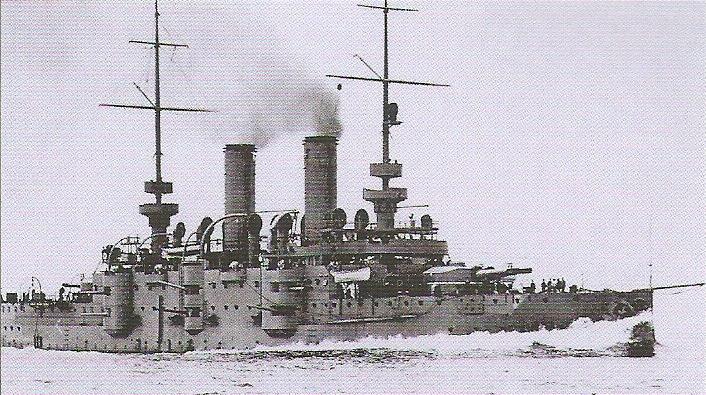
Design of the Habsburg class
With artillery of this caliber, armor was rated accordingly and therefore considerably lower than on many contemporary battleships. Finally, the small size of the hull implied a limitation of available space for boilers, but its had fortunately no consequences in terms of speed. With 19.6 to 19.8 knots, these battleships were in the norm. Among other peculiarities, they sported their secondary artillery in two stages barbettes, making them very recognizable. This configuration was later abandoned. Main artillery consisted of the three Krupp 9.4 in 40 caliber C97, and 150 mm Krupp of 40 caliber C96, whereas anti-TB armament comprised 70 mm Skoda 45 caliber and 47 mm Skoda 44 and 33 caliber rapid fire guns placed in the superstructures.
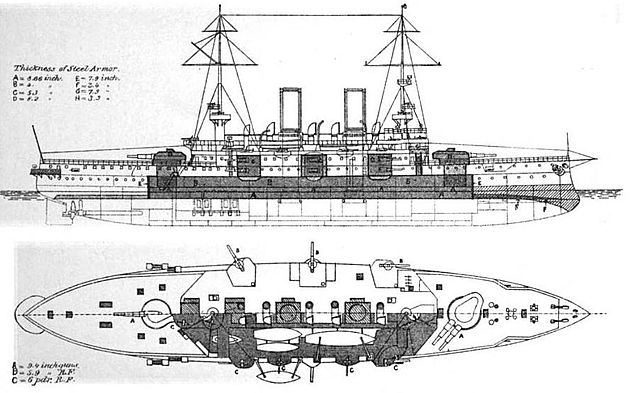
Jane’s profile of the ships
The choice to place the double turret forward, in chase mode, also responded to the lack of armor at the rear. The belt was 2.44 m high, at the waterline, extending over the ram to a thickness of 100 mm. The blockhaus was reinforced by two 220 mm crosspieces, and the central bulkhead was 63 mm in thickness. The double casemates were protected by 125 mm of armor. The central casemates had a more pronounced corbelling which, added to the shape of the hull at this location, allowed a 180° angle. The engine consisted of two four-cylinder, triple-expansion engines, combined with the low displacement of the vessel allowed a good top speeds, exceeding 20 knots during sea trials. On two ships, the additional weight had been eliminated by removing a deck in 1911. Range was limited to 3,200 nautical miles, mainly because of the ships’s reduced holds for coal, of only 800 tons, but logical in a planned use in the Adriatic.
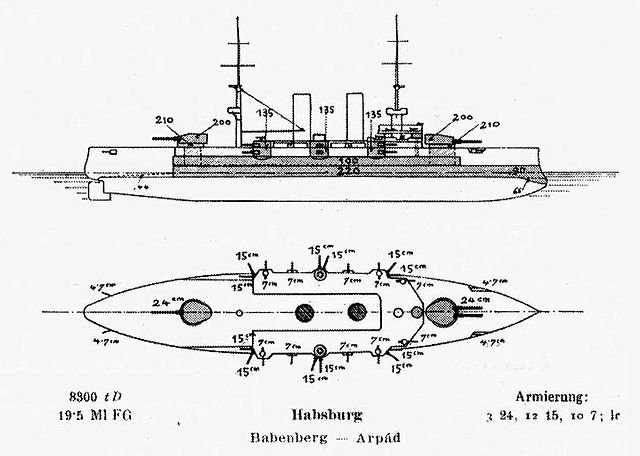
Brassey’s diagram of the class
The Habsburg class in action
The Habsbug, Harpàd and Babenberg were started at STT (Stabilimento Tecnico Triestino) from 1899, launched between 1900 and 1902 and entered service in 1902-1904.
In 1914, these three units formed the 4th Line Division within the Active Squadron. The name did not reflect their activity precisely, because apart from the Habsburg who shellied Ancona, and after the first operation on the Montenegrin coast by the three battleships, they remained anchored in Pola until 1918. In 1917 they were decommissioned as coastal defense ships already. In 1919, the peace treaty had them attributed to Great Britain who had them broken up in Italy in 1921.
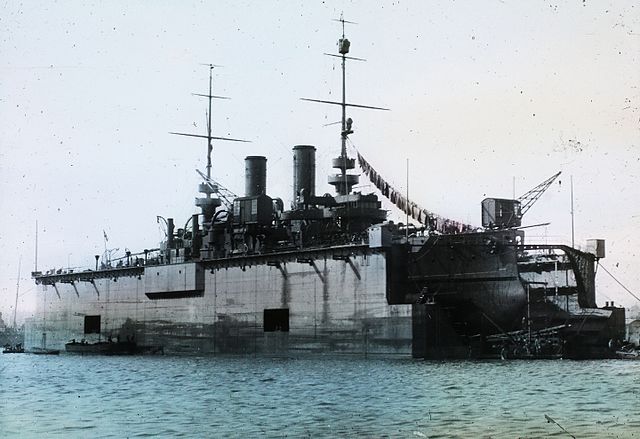
SMS Habsburg in drydock
SMS Habsburg
Habsburg and Árpád took part in fleet maneuvers in mid-1903. In 1904 the three Habsburg-class battleships engaged the three Monarch-class battleships in a simulated battle which also saw for first time two squadrons of modern battleships. They joined the I Battleship Division. Habsburg served in the Mediterranean Sea, starting a training cruise in January 1903. However with the acceptance of the Karl-class battleships from 1906 the Habsburg-class ships were ended in the II Division and in in 1910 SLS Habsburg entered drydock for a comprehensive modernization. She was also lightened with one deck removed and sh becae a coastal defense vessel.
In August 1914, Habsburg was the flagship of the III Battleship Division under command of famous Captain Miklós Horthy. She was mobilized to support the SMS Goeben and SMS Breslau “mad run” towards the Dardanelles. The squadron was recalled after advancing as far south as Brindisi in southeastern Italy, probably the longest trip these ships ever made in wartime.
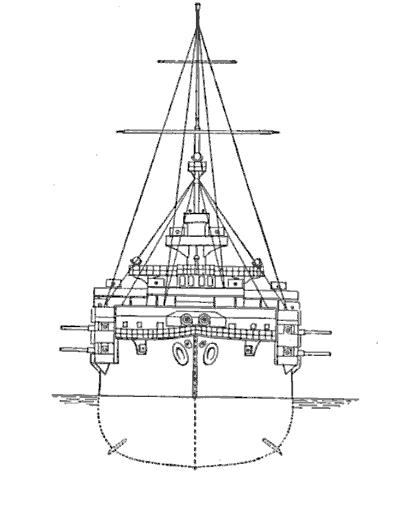
Habsburg class bow
Habsburg was transferred to the IV Division with the arrival of the new Tegetthoff-class battleships and went to shell several Italian ports along the Adriatic coast. In particular Habsburg bombarded Ancona on 23 May 1915, reducing to rubble the town’s train station, the St. Stefano military camp and dueled with Ancona coastal batteries. However after this actionshe sailed back to Pola. The shortage of coal and superiority of the italaian Navy, and soon of the Entente naval focres in the area, condemned the ships to inaction, or waiting for n eventual sortie. Habsburg was decommissioned in Pola and became as a harbor defense vessel while Her crew was transferred to the new U-boats and aircraft of the fleet. In 1918, she was re-commissioned as a training ship and joined the Austrian Naval Academy. She was awarded to UK as a war prize, resold to Italy and broken up for scrap in 1921, like her two sisters.
SMS Árpád
Árpád participated from 1903 in many fleet drills and simulated war games with the I Battleship Division. She went in a long training cruise in the Mediterranean with the Monarch-class battleships and was later relegated to the II Battleship Division. From 1910 Árpád went through the same drydock modifications, her superstructure decks being removed to save weight. During the war she served with the IV Division and was mobilized during the Goeaben flight, to support her in the strait of Messina against British vessels. In 1915 she raided several Italian port cities along the Adriatic coast and Ancona on 23 May 1915, but afterwards came back to Pola and stayed there in total inaction until the end of the war.
SMS Babenberg
She was commissioned in 1904, first with the I Battleship Divisio, then II Battleship Division, and apparently from 1912, the IV Division of the Austro-Hungarian Navy. Like her sisters, SMS Babenberg sailed to support the Goeben rush in the Mediterranean, about as far as the strait of Messina to be prepared to duel with British ships here, and turned back off Brindisi. Like the others she bombarded Ancona in 1915 but returned to Pola and was confiend there, with a reduced crew, decommissioned and used as a harbor defense ship. She became a war prize in 1921 for UK which had them resold to an Italian demolition shipyard.
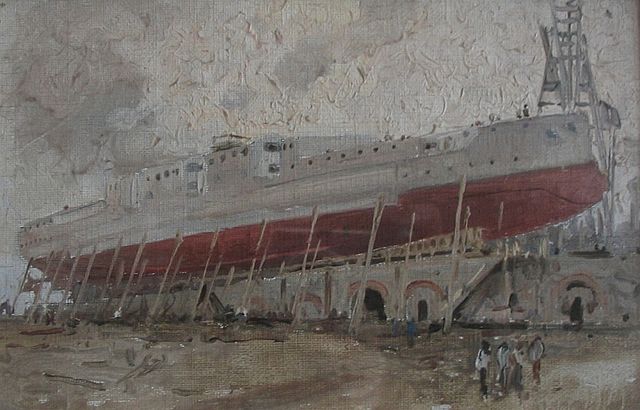
Habsburg being launched at the Stabilimento Tecnico Triestino in 1900
Habsburg class specifications |
|
| Dimensions | 114.5 x 19.8 x 7.46 m (375 ft 10 in x 65 ft x 24 ft 6 in) |
| Displacement | 8230T standard, 8800T FL |
| Crew | 638 |
| Propulsion | 2 shafts 2 VTE, 16 Belleville boilers, 15,063 ihp (11,232 kW) |
| Speed | 19 knots (35 km/h; 22 mph) – 19.5 trials |
| Armament | 3 x 240, 12 x 150, 10 x 70, 8 x 47 mm, 2 side sub. 450 mm TTs | Armor | Belt 220, turrets 280, casemates 210, decks 40, blockhouse 200 mm |
Links and sources
The Habsburg class on wikipedia
On shipspotting.com
On battleships-cruisers.co.uk
Conway’s all the world fighting ships 1865-1905
Gallery

Author’s Illustration profile of the Habsburg – 1/730


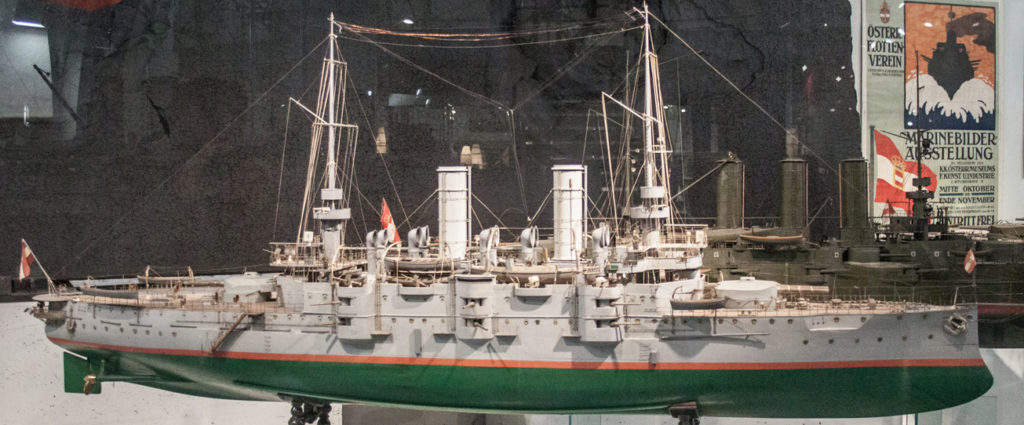
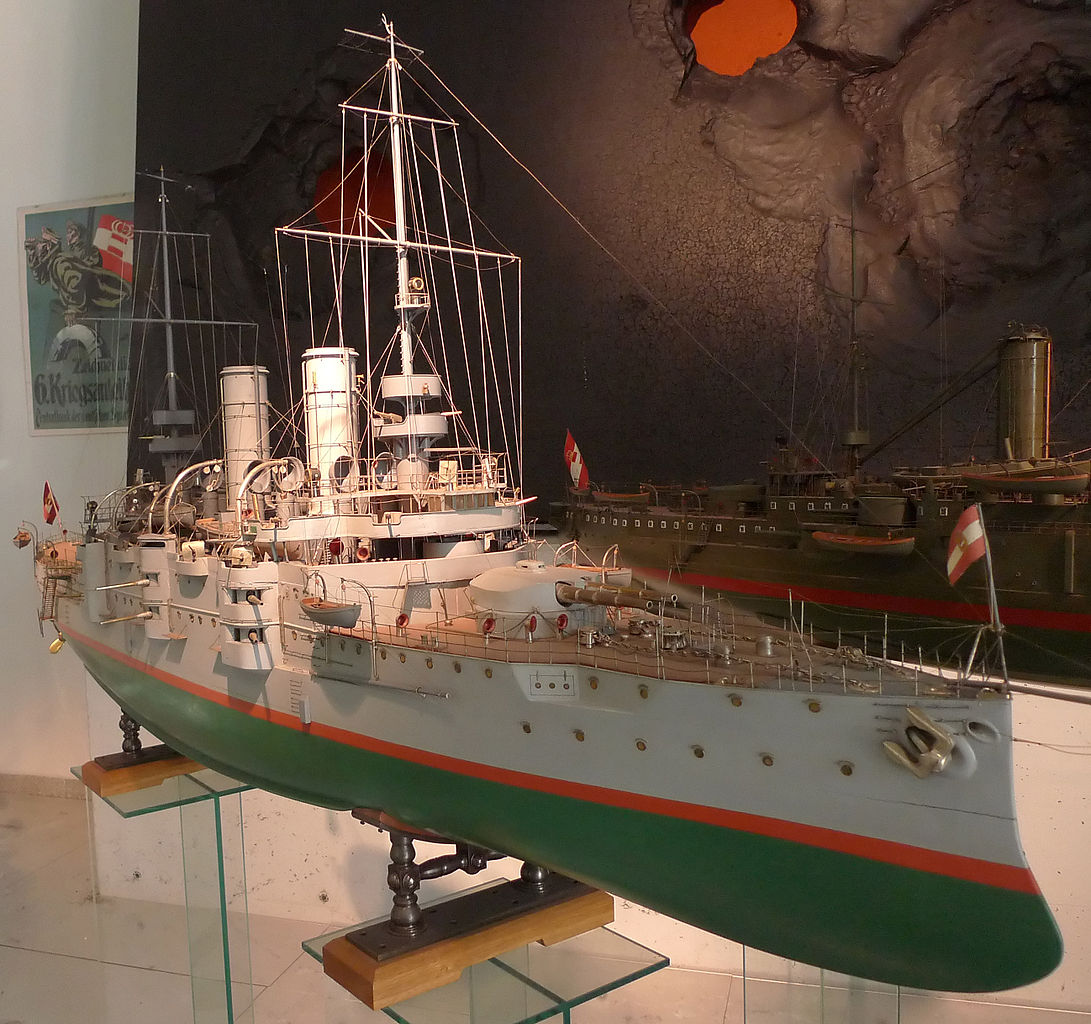
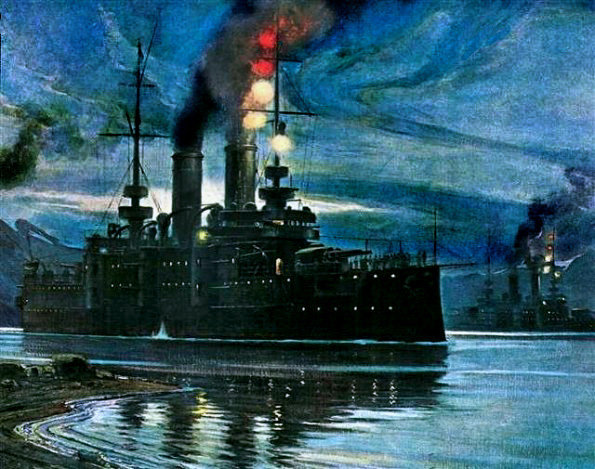
 Latest Facebook Entry -
Latest Facebook Entry -  X(Tweeter) Naval Encyclopedia's deck archive
X(Tweeter) Naval Encyclopedia's deck archive Instagram (@navalencyc)
Instagram (@navalencyc)





 French Navy
French Navy Royal Navy
Royal Navy Russian Navy
Russian Navy Armada Espanola
Armada Espanola Austrian Navy
Austrian Navy K.u.K. Kriegsmarine
K.u.K. Kriegsmarine Dansk Marine
Dansk Marine Nautiko Hellenon
Nautiko Hellenon Koninklije Marine 1870
Koninklije Marine 1870 Marinha do Brasil
Marinha do Brasil Osmanlı Donanması
Osmanlı Donanması Marina Do Peru
Marina Do Peru Marinha do Portugal
Marinha do Portugal Regia Marina 1870
Regia Marina 1870 Nihhon Kaigun 1870
Nihhon Kaigun 1870 Preußische Marine 1870
Preußische Marine 1870 Russkiy Flot 1870
Russkiy Flot 1870 Svenska marinen
Svenska marinen Søværnet
Søværnet Union Navy
Union Navy Confederate Navy
Confederate Navy Armada de Argentina
Armada de Argentina Imperial Chinese Navy
Imperial Chinese Navy Marinha do Portugal
Marinha do Portugal Mexico
Mexico Kaiserliche Marine
Kaiserliche Marine 1898 US Navy
1898 US Navy Sovietskiy Flot
Sovietskiy Flot Royal Canadian Navy
Royal Canadian Navy Royal Australian Navy
Royal Australian Navy RNZN Fleet
RNZN Fleet Chinese Navy 1937
Chinese Navy 1937 Kriegsmarine
Kriegsmarine Chilean Navy
Chilean Navy Danish Navy
Danish Navy Finnish Navy
Finnish Navy Hellenic Navy
Hellenic Navy Polish Navy
Polish Navy Romanian Navy
Romanian Navy Turkish Navy
Turkish Navy Royal Yugoslav Navy
Royal Yugoslav Navy Royal Thai Navy
Royal Thai Navy Minor Navies
Minor Navies Albania
Albania Austria
Austria Belgium
Belgium Columbia
Columbia Costa Rica
Costa Rica Cuba
Cuba Czechoslovakia
Czechoslovakia Dominican Republic
Dominican Republic Haiti
Haiti Hungary
Hungary Honduras
Honduras Estonia
Estonia Iceland
Iceland Eire
Eire Equador
Equador Iran
Iran Iraq
Iraq Latvia
Latvia Liberia
Liberia Lithuania
Lithuania Mandchukuo
Mandchukuo Morocco
Morocco Nicaragua
Nicaragua Persia
Persia San Salvador
San Salvador Sarawak
Sarawak Uruguay
Uruguay Venezuela
Venezuela Zanzibar
Zanzibar Warsaw Pact Navies
Warsaw Pact Navies Bulgaria
Bulgaria Hungary
Hungary

 Bundesmarine
Bundesmarine Dutch Navy
Dutch Navy Hellenic Navy
Hellenic Navy Marina Militare
Marina Militare Yugoslav Navy
Yugoslav Navy Chinese Navy
Chinese Navy Indian Navy
Indian Navy Indonesian Navy
Indonesian Navy JMSDF
JMSDF North Korean Navy
North Korean Navy Pakistani Navy
Pakistani Navy Philippines Navy
Philippines Navy ROKN
ROKN Rep. of Singapore Navy
Rep. of Singapore Navy Taiwanese Navy
Taiwanese Navy IDF Navy
IDF Navy Saudi Navy
Saudi Navy Royal New Zealand Navy
Royal New Zealand Navy Egyptian Navy
Egyptian Navy South African Navy
South African Navy






























 Ukrainian Navy
Ukrainian Navy dbodesign
dbodesign